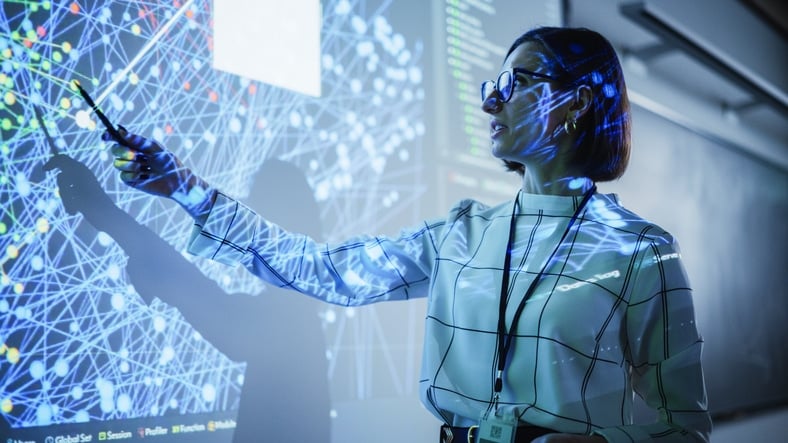AI in Education
AI in education unfolds a narrative where opportunities and challenges are intertwined. It’s a journey of transformation where education isn’t just about information but is about personalised, interactive, and responsive learning experiences. Teachers transform into facilitators,
Opportunities for Teachers:
Personalised Learning Pathways
AI empowers teachers to create personalised learning pathways for students. Algorithms analyse individual learning styles, pace, and preferences, aiding teachers in crafting customised lesson plans. It elevates teaching from a generalised approach to a student-centric model, where every student’s unique learning needs are addressed.

Data-Driven Insights
AI provides a wealth of data-driven insights. Teachers can track students’ progress, engagement levels, and learning patterns. It offers a granular view of each student’s learning journey, empowering teachers with data to make informed instructional decisions.
Efficient Assessment Systems
AI automates the assessment process, providing real-time feedback. Teachers gain insights into students’ strengths and weaknesses, enabling targeted intervention. It saves time and effort, allowing teachers to focus on interactive teaching rather than administrative tasks.
Challenges for Teachers:
Ethical Concerns
AI in classrooms brings ethical considerations. Data privacy, consent, and security are paramount. Teachers need to navigate these ethical terrains ensuring students’ data is protected, and AI is used responsibly.

Technology Integration
Integrating AI requires upskilling. Teachers need to adapt to technology, understand AI functionalities, and navigate potential complexities. It demands continuous learning and adaptation, turning teachers into perpetual students of evolving technology.
Emotional and Social Skills
AI, though efficient, lacks the human touch. Teachers face the challenge of balancing technology and human interaction, ensuring that students’ emotional and social skills are nurtured alongside academic learning.
– SmartEducator: Coming September 2024! –
Smart Educator is a tool that takes the daily stress of marking and feedback off teachers, and acts as a support tool tohelp teachers be more productive and give more accurate results

Opportunities for Students:
Global Learning Platforms
AI extends learning beyond physical classrooms. Students access global platforms, interact with peers worldwide, and explore a myriad of learning resources. It breaks geographical barriers, turning the world into a classroom.

Adaptive Learning Environments
AI creates adaptive learning environments for students. They engage with interactive and responsive learning modules that adapt to their pace and style. Learning becomes a personalised journey, tailored to each student’s needs.
Real-Time Support
AI-powered chatbots provide real-time support. Students seek assistance, clarify doubts, and explore additional learning materials instantaneously. It ensures that learning isn’t interrupted and support is always accessible.
Challenges for Students:
Skill Development
AI, while enhancing academic learning, might potentially sideline the development of soft skills. Students face the challenge of balancing AI-driven learning and the development of emotional, social, and interpersonal skills.

Data Privacy
Students’ data becomes a crucial element in AI-driven education. Protecting this data, ensuring privacy, and navigating the complex terrains of consent and security become intrinsic challenges.
Digital Divide
AI’s integration exacerbates the digital divide. Students with access to technology benefit, while others are left behind. It creates a disparity that impacts equitable access to quality education
The future of education is here
Click the button to start your FREE 30 day SmartEducator Trial!
The Balanced Approach
AI’s integration in education isn’t a linear journey but a complex intersection of opportunities and challenges. For teachers, AI emerges as a tool enhancing efficiency, personalisation, and data-driven teaching. However, it also demands upskilling, ethical navigation, and a balanced approach to ensure the holistic development of students.
Students step into a world where learning is personalised, support is instantaneous, and global platforms are accessible. However, they also step into a world where data privacy is a concern, the digital divide is real, and the development of soft skills requires conscious effort.
Future-Proofing Your AI Model
Building an AI model isn’t a one-time feat but an evolving journey. Models need to be updated, refined, and adapted to align with the changing data, emerging trends, and evolving objectives. Maintenance, updates, and continuous improvement ensure that the model remains a strategic asset, delivering sustained value over time.
Policy and Practice
Policies need to address the ethical and security aspects of AI. It’s about creating frameworks that protect students’ data, ensure informed consent, and uphold privacy. In practice, the integration of AI should be accompanied by efforts to bridge the digital divide, ensuring that every student, irrespective of their socio-economic background, has access to quality AI-driven education.
Human and AI Synergy
The synergy of human and AI in education should be nurtured. Teachers aren’t replaced but are empowered by AI. Their role transforms from administrative and instructional to facilitative and strategic. Students aren’t just passive recipients of AI-driven learning but are active participants in a learning ecosystem that’s responsive, adaptive, and personalized.
